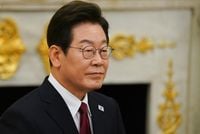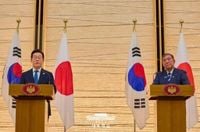In a symbolic and potentially pivotal moment for Northeast Asian diplomacy, Japanese Prime Minister Shigeru Ishiba and South Korean President Lee Jae Myung convened in the bustling port city of Busan on September 30, 2025, for what is likely their final summit as counterparts. The meeting, which lasted 75 minutes and started at 4:50 p.m. local time, capped a series of three summits between the two leaders and underscored a shared determination to forge a new chapter in the often-turbulent relationship between their nations.
The summit took place against a backdrop of significant regional and global shifts. With U.S. President Donald Trump’s transactional approach to alliances and his aggressive use of tariffs, Japan and South Korea—longtime U.S. allies with a complicated shared history—have been nudged closer together out of both necessity and opportunity. According to the Associated Press, both leaders emphasized the urgency of strengthening ties in a world where old certainties are rapidly eroding.
“I hope that (South) Korea and Japan can grow closer emotionally, economically, socioculturally, and in terms of security, just as they are in physical distance,” Lee said at the start of the meeting, as reported by AP. Ishiba, facing imminent departure after offering to resign following his coalition’s election defeat, described the summit as “deeply meaningful” and said, “By sharing each other’s wisdom and experience, we can strengthen relations between our two countries while addressing our common challenges.”
The two leaders issued a joint statement pledging to establish a consultative body that would address pressing social and economic issues common to both countries, such as declining birth rates, aging populations, balanced national development, rural revitalization, agriculture, disaster management, and suicide prevention. This step, as The Korea Herald noted, reflects a strategic intent to formalize bilateral diplomacy and ensure that dialogue continues even as political winds shift.
Security was front and center at the summit, especially with North Korea’s nuclear ambitions looming ever larger. Despite recent statements by North Korean leader Kim Jong Un signaling no intention to relinquish nuclear weapons, Lee and Ishiba reaffirmed their “unchanged will to denuclearize the Korean Peninsula,” according to Kang Yoo-jeong, spokesperson for the South Korean Presidential Office. The leaders’ commitment to this goal was reiterated in their joint statement, signaling to the region—and the world—that Seoul and Tokyo remain united on this critical issue.
Yet, the summit was not just about high-level agreements. The leaders discussed plans to jointly establish an Arctic shipping trade route, a move that could have major ramifications for global commerce as melting ice opens new passages. They also agreed to coordinate their responses to shifts in global trade, a nod to the economic pressures both countries face from U.S. tariffs and the rise of a China-North Korea-Russia bloc in the region, as reported by The Chosun Daily.
The recent history between South Korea and Japan has been fraught with tension, much of it rooted in Japan’s colonial rule over Korea from 1910 to 1945. Disputes over historical memory, territorial claims—such as the ongoing Dokdo/Takeshima island controversy—and compensation for wartime victims have repeatedly strained ties. Yet, as AP and The Korea Times observed, relations began to thaw under Lee and Ishiba’s predecessors, and both leaders have sought to build on that momentum.
Lee’s approach has sometimes raised eyebrows, especially among policymakers in Washington and Tokyo. During his presidential campaign, he was accused of taking a hard line on Japan, demanding apologies for the so-called “comfort women” and other victims of colonial-era abuses. However, Lee’s decision to visit Tokyo for his first bilateral summit before heading to Washington in August 2025 was widely seen as a gesture of goodwill and a signal of his willingness to pursue “pragmatic diplomacy and build future-oriented relations with Japan,” as he stated during that visit.
For his part, Ishiba has been more open than many of his political peers about acknowledging Japan’s wartime aggression and expressing empathy for Asian victims. This openness was welcomed in Seoul, but his resignation—prompted by his party’s election loss—casts uncertainty over the future. “Ishiba acknowledged enduring differences with South Korea over wartime history but stressed the need for Tokyo to maintain ‘sincerity and courage’ in confronting the past,” AP reported. He added that he hopes his successor will continue to strengthen bilateral ties, which would “not only benefit the two countries but also the entire world.”
The leaders’ efforts to institutionalize dialogue come at a time when both countries face demographic crises—declining birth rates and rapidly aging populations threaten economic vitality and social stability. By agreeing to consult on these and other shared challenges, Lee and Ishiba hope to create a durable framework for cooperation that will outlast their own tenures.
Economic pressures from the United States have also played a significant role in drawing Seoul and Tokyo closer. In hopes of avoiding the highest tariffs imposed by the Trump administration, both nations have pledged massive investments in U.S. industries. South Korea has proposed a $350 billion package, structured through loans and loan guarantees, though it remains at odds with Washington over the specifics. Japan, meanwhile, has already inked a deal with the U.S., reducing tariffs on automobiles and other imports from 25% to 15% and committing $550 billion in investment, according to AP.
Despite these converging interests, the path forward is far from smooth. With Ishiba’s departure, there is widespread speculation that a more hawkish conservative could become Japan’s next prime minister, potentially reviving old disputes and derailing progress. As The Korea Herald pointed out, many in Seoul believe that Tokyo must do more to reckon with its historical responsibilities, drawing comparisons to Germany’s efforts after World War II.
Still, there is a sense of cautious optimism. Lee described the summit as “the epitome of shuttle diplomacy,” emphasizing the importance of frequent and active exchanges for joint development and security. “I expect today’s summit to lay a cornerstone for rebranded Korea-Japan relations,” he said, as quoted by UPI.
As the dust settles on this third and likely final summit between Lee and Ishiba, both leaders have clearly signaled a desire to leave behind a legacy of cooperation. Whether their efforts will withstand the pressures of history, politics, and shifting alliances remains to be seen, but for now, the groundwork has been laid for a more stable and constructive relationship between two of Asia’s most important neighbors.

